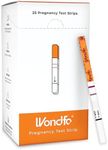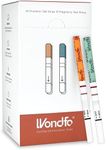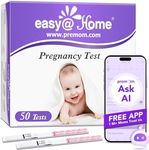Buying Guide for the Best Earliest Pregnancy Test
Choosing the right pregnancy test can feel overwhelming, especially when you want results as early as possible. The key is to understand how these tests work and what features matter most for your needs. Early pregnancy tests detect a hormone called hCG in your urine, which your body starts producing after a fertilized egg attaches to your uterus. The best test for you depends on how soon you want to test, how easy you want the process to be, and how much clarity you need in the results.Sensitivity (hCG Detection Level)Sensitivity refers to the lowest amount of the pregnancy hormone (hCG) that the test can detect, usually measured in milli-international units per milliliter (mIU/mL). The lower the number, the more sensitive the test is, and the earlier it can potentially detect pregnancy. Tests with sensitivity around 10-15 mIU/mL can sometimes detect pregnancy a few days before your missed period, while those with 20-25 mIU/mL are more likely to give accurate results on or after the day of your missed period. If you want to test as early as possible, look for a test with a lower hCG detection level, but keep in mind that testing too early can sometimes lead to false negatives.
Result Clarity (Display Type)Result clarity is about how easy it is to read and interpret the test result. Some tests use simple lines, while others have digital displays that show words like 'pregnant' or 'not pregnant.' Line tests can sometimes be confusing, especially if the line is faint, while digital tests are usually clearer but may cost more. If you want a straightforward answer without second-guessing, a digital display might be best for you. If you’re comfortable interpreting lines and want a more traditional approach, a line test could work well.
Testing Method (Midstream vs. Dipstick)The testing method refers to how you use the test. Midstream tests are held directly in your urine stream, making them quick and convenient. Dipstick tests require you to collect urine in a cup and then dip the test strip in. Midstream tests are generally easier and less messy, while dipsticks can be more affordable and sometimes come in larger packs. If you value convenience and simplicity, midstream tests are a good choice. If you don’t mind a little extra effort and want to test multiple times, dipsticks might suit you.
Time to ResultTime to result is how long you have to wait before reading the test. Most tests give results within 1 to 5 minutes. Faster tests can be less stressful if you’re anxious, but all reputable tests are accurate if used correctly. If you want quick reassurance, look for tests that promise results in a minute or two. If waiting a few extra minutes isn’t a concern, this spec may not be as important for you.
Ease of UseEase of use covers how simple the instructions are and how easy the test is to handle. Some tests have ergonomic designs or larger handles, making them easier to use, especially if you’re nervous or testing early in the morning. If you want a stress-free experience, look for tests with clear instructions and user-friendly designs. If you’re comfortable following basic steps, most standard tests will work fine.

















